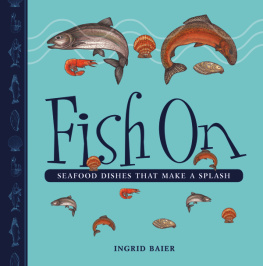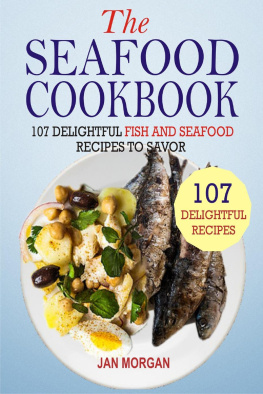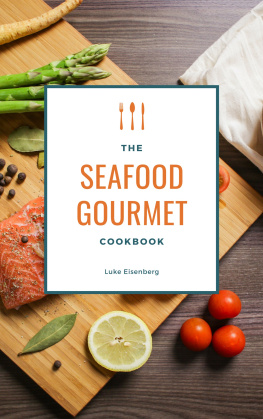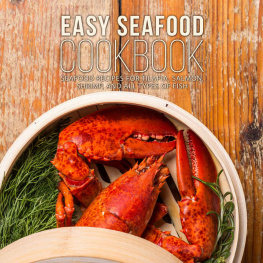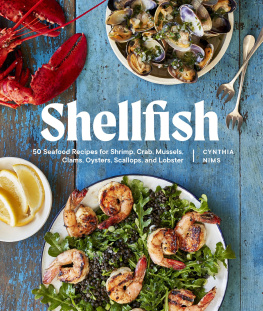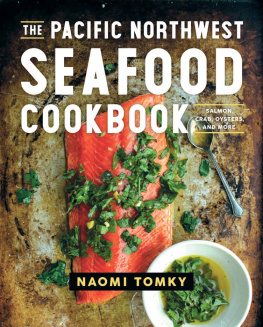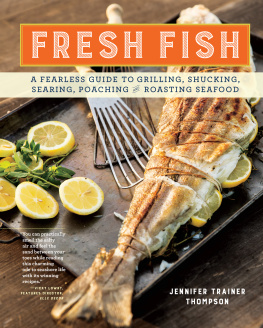About Halibut
The largest of all the flatfish, Pacific halibut can reach weights of over 700 pounds (315 kilograms), and its Latin name, Hippoglossus stenolepis , translates as hippo of the sea. Interestingly, juvenile halibuts start life torpedo-shaped, like salmon, with one eye on either side of their heads but, after a few months, the left eye migrates over to the right side, the pigmentation on the left side fades to white, and the fish subsequently changes its orientation in the water. They become voracious carnivores and use camouflage to avoid detection from their prey: viewed from above, their dark, mottled tops allow them to blend seamlessly into the ocean floor, and their white bellies obscure their outlines against the bright surface of the water when seen from below.
Halibut has mild-tasting, firm white flesh that is low in fat, and has the culinary advantage of having very few bones. It is available fresh from March through November, and, properly wrapped, it will freeze well for several months.
Because of their large size, halibut steaks are cut close to the tail and the main part of the body is cut into fillets. The cheeks, considered a delicacy, are removed and sold separately. As with all seafood, source this fish from a reputable fishmonger or a grocery store with a high turnover and clean, glass-covered display cases. Whole halibut is rarely available commercially, but if you are interested in cooking a whole fish, you may be able to special order a chicken (less than 20 pounds [9 kilograms]), from a cannery or specialty fishmonger.
In terms of sustainability, longline-harvested Pacific halibut are the best choice; avoid trawl-harvested Atlantic halibut and flounder.
About Leftovers
We all have them: those little foil-wrapped science experiments at the back of the fridgethe leftover roast that we diligently put into a reusable container, and then forgot to date; the gelatinized stew with the skim of fat across the top, eyeing us balefully from the top shelfsilently screaming eat me every time we open the fridge.
So we close the door and pretend we didnt see them. We feel guilty about throwing out good food and our strategy seems to be to let it turn green because then we can toss it out in good conscience. Because, the truth is, figuring out what to do with leftovers can be more challenging than planning a whole new meal. Its tough to turn leftovers into something palatable, and if you have picky kids, well... sometimes it just seems like more effort than its worth.
But its an effort that we should make. The trashcan is indeed a dismal fate for any animal slaughtered for food, and tossing out a salmon fillet because we forgot about it, or grilling twice as much halibut as we can reasonably eat because we ran out of freezer bags, undermines the very tenets of sustainable fishing. Seafood is a precious resource and the easiest steps we can take towards responsible ocean stewardship are to cook what we buy, and to eat what we cook.
On the lighter side, using up cold, leftover seafood is easier than it looks. With the exception of bivalves, which dont reheat all that well and are best turned into dips, most seafood can be reinvented into tomorrows lunch in the form of savoury tarts, pts, quiches, and salads (and, in a pinch, even leftover mussels can be tossed into pasta sauce at the very last minute to just heat through).
Acknowledgments
First thanks go to my husband, Ted, who has supported me through many whacky adventures for more than sixteen years, believing in me long before I learned to believe in myself. If not for his love and encouragement, this book would still be a pile of grease-spattered notes in the kitchen drawer.
To my son, Gabriel, who ferried coffee (or wine, depending on how it was going), to my study during the writing process, and to my daughter, Jessica, who inquired with genuine compassion whether I was nearly done my homework.
To my sister, Freya Lee, for reading the first draft and succinctly pointing out that Ive never met an adjective I didnt like; had I sent the original ten-pound manuscript, it probably would have been met with a rejection letter.
To my mother, Ann Hory, for her unlimited encouragement and her help with the recipes; my father, Frank Hory, for teaching me to fish all those years ago; and to my brother, Andrew James, who always helped me to pull up the crab traps, even though hes a staunch vegetarian.
To Debbie Harding for her illustrations.
Special thanks go to Ruth Linka, for taking a chance on an unknown writerparticularly an unknown writer who isnt even a qualified chefand for her patience and generosity of spirit in introducing a first-time author to the publishing industry.
To Holland Gidney, for her insightful editing, gentle correction, and especially her warm words of encouragement early in the process.
To Pete Kohut, for his great design and remarkable ability in getting the manuscript to fit the space.
And to Tara Saracuse, for her encouragement, lightning fast emails, great advice, and unflagging efforts in promoting this book.
Its been a steep learning curve, and Ive enjoyed every minute.
Bacon-wrapped Oysters
Bacon is a popular wrapping for a variety of foods ranging from beef tenderloin to scallops but the contrast between fresh briny oysters and crispy bacon is particularly enticing. Par-cooking the oysters makes them much easier to wrap, and par-cooking the bacon not only renders the fat, but also narrows the disparate cooking times between the two foods.
Beer Suggestion: Guinness stout
- 12 oz (355 mL) freshly shucked oysters
- 1 tsp (5 mL) unsalted butter
- 8 slices thick-cut bacon
- freshly ground pepper, to taste
- 1 small red onion, quartered
- 16 cocktail sticks, soaked in water for at least 15 minutes
1. In a large frying pan, on medium-low heat, par-cook the bacon until most of the fat has rendered (do not allow it to crisp). Drain on paper towels until cool enough to handle.
2. Drain the oysters in a colander. Cut any large ones in half and season liberally with freshly ground pepper.
3. In a medium, non-stick frying pan, melt the butter on medium heat and par-cook the oysters until they firm up slightly, about 3 minutes, to make it easier for wrapping the bacon (otherwise they tend to implode during staking).
4. Cut the par-cooked bacon slices in half and wrap one piece of bacon around each oyster, overlapping the edges slightly. Stake each oyster with a cocktail stick and bracket the oyster on both sides with a chunk of red onion.
5. Preheat the broiler to high and broil the oysters close to the heat until the bacon is crisp and the oyster is cooked through, about 2 minutes (or more, according to taste). Serve immediately with .
Serves 4 as a starter.
Baked Crab and Artichoke Dip
Served as a starter with toasted baguette rounds, this succulent dip is the absolute best way to stretch a single Dungeness between four people.
- 1 12-oz (355 mL) jar artichoke hearts
- 1 Tbsp (15 mL) unsalted butter
- 2 Tbsp (30 mL) minced white onion
- 1 garlic clove, minced
- tsp (2 mL) salt
- freshly ground pepper, to taste
- 2 Tbsp (30 mL) dry white wine
- 1 tsp (5 mL) Dijon mustard
- 1 tsp (5 mL) Tabasco sauce
- cup (125 mL) whipping cream
- cup (125 mL) grated Gruyre cheese
- cup (60 mL) freshly grated Parmesan cheese
- 2 Tbsp (30 mL) minced fresh tarragon, for garnishing

